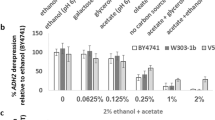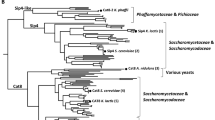Abstract
Promoter regions of the KlQCR7, KlQCR8 and KlCYC1 genes, coding for subunits of the bc 1-complex and cytochrome c respectively, in the shortterm Crabtree-negative yeast Kluyveromyces lactis differ markedly in sequence from their Saccharomyces cerevisiae counterparts. They have, however, conserved very similar configurations of binding-site motifs for various transcription factors known to be involved in global and carbon-source regulation in S. cerevisiae. To investigate the carbon source-dependent expression of these genes in K. lactis, we have carried out medium-shift experiments and determined transcript levels during the shifts. In sharp contrast to the situation in S. cerevisiae, the level of expression in K. lactis is not affected when glucose is added to a non-fermentable carbon-source medium. However, the genes are not constitutively expressed, but become significantly induced when the cells are shifted from glucose to a nonfermentable carbon source. Finally, induction of transcriptional activation does not occur in media containing both glucose and non-femmentable carbon sources.
Similar content being viewed by others
References
Anderson MS, Yarger JG, Burck CL, Poulter CD (1989) Farnesyl diphosphate synthetase. Molecular cloning, sequence, and expression of an essential gene from Saccharomyces cerevisiae. J Biol Chem 264:19176–19184
Bowman SB, Zaman Z, Collinson LP, Brown AJP, Dawes IW (1992) Positive regulation of the LPD1 gene of Saccharomyces cerevisiae by the HAP2/HAP3/HAP4 activation system. Mol Gen Genet 231:296–303
Chodosh LA, Olesen J, Hahn S, Baldwin AS, Guarente L, Sharp PA (1988) A yeast and a human CCAAT-binding protein have heterologous subunits that are functionally interchangeable. Cell 53:25–35
Crabtree (1929) Observations on the carbohydrate metabolism of tumors. Biochem J 23:536
Czyz M, Nagiec MM, Dickson RC (1993) Autoregulation of GAL4 transcription is essential for rapid growth of Kluyveromyces lactis on lactose and galactose. Nucleic Acids Res 21:4378–4382
De Deken RH (1966) The Crabtree effect: a regulatory system in yeast. J Gen Microbiol 44:149–156
De Winde JH, Grivell LA (1992) Global regulation of mitochondrial biogenesis in yeast: ABF1 and CPF1 play opposite roles in regulating expression of the QCR8 gene, encoding subunit VII of the mitochondrial ubiquinol cytochrome c oxidoreductase. Mol Cell Biol 12:2872–2883
Deshler JO, Larson GP, Rossi JJ (1989) Kluyveromyces lactis maintains Saccharomyces cerevisiae intron-encoded splicing signals. Mol Cell Biol 9:2208–2213
Diffley JFX (1992) Global regulators of chromosome function in yeast. An van Leeuwenhoek Int J Gen Mol Microbiol 61:25–33
Entian KD, Barnett JA (1992) Regulation of sugar utilization by Saccharomyces cerevisiae. Trends Biochem Sci 17:506–510
Forsburg SL, Guarente L (1989a) Communication between mitochondria and nucleus in the regulation of cytochrome genes in the yeast Saccharomyces cerevisiae. Annu Rev Cell Biol 5:153–180
Forsburg SL, Guarente L (1989b) Identification and characterization of HAP4: a third component of the CCAAT-bound HAP2/HAP3 heteromer. Genes Dev 3:1166–1178
Freire-Picos MA, Rodriguez-Torres AM, Ramil E, Cerdan ME, Breunig KD, Hollenberg CP, Zitomer RS (1993) Sequence of a cytochrome c gene from Kluyveromyces lactis and its upstream region. Yeast 9:201–204
Gancedo JM (1992) Carbon catabolite repression in yeast. Eur J Biochem 206:297–313
Gonçalves PM, Maurer K, Mager WH, Planta RJ (1992) Kluyveromyces contains a functional ABF1-homologue. Nucleic Acids Res 20:2211–2215
Griggs DW, Johnston M (1993) Promoter elements determining weak expression of the GAL4 regulatory gene of Saccharomyces cerevisiae. Mol Cell Biol 13:4999–5009
Käppeli O, Sonnleitner B (1986) Regulation of sugar metabolism in Saccharomyces-type yeast: experimental and conceptual considirations. Crit Rev Biotechnol 4:299–325
Keng T, Guarente L (1987) Constitutive expression of the yeast HEM1 gene is actually a composite of activation and repression. Proc Natl Acad Sci USA 84:9113–9117
Li XY, Mantovani R, Hooft van Huijsduijnen R, Andre I, Benoist C, Mathis D (1992) Evolutionary variation of the CCAAT-binding transcription factor NF-Y. Nucleic Acids Res 20:1087–1091
Lodi T, O'Connor D, Goffrini P, Ferrero I (1994) Carbon catabolite repression in Kluyveromyces lactis: isolation and characterization of the KlDLD1 gene encoding the mitochondrial enzyme D-lactate ferricytochrome c oxidoreductase. Mol Gen Genet 244:622–629
Lombardo A, Cereghino GP, Scheffler IE (1992) Control of mRNA turnover as a mechanism of glucose repression in Saccharomyces cerevisiae. Mol Cell Biol 12:2941–2948
Maarse AC, De Haan M, Bout A, Grivell LA (1988) Demarcation of a sequence involved in mediating catabolite repression of the gene for the 11 kDa subunit VIII of the ubiquinol cytochrome c oxidoreductase in Saccharomyces cerevisiae. Nucleic Acids Res 16:5797–5811
Mazzoni C, Saliola M, Falcone C (1992) Ethanol-induced and glucose-insensitive alcohol dehydrogenase activity in the yeast Kluyveromyces lactis. Mol Microbiol 6:2279–2286
Mulder W, Scholten IHJM, De Boer RW, Grivell LA (1994a) Sequence of the HAP3 transcription factor of Kluyveromyces lactis predicts the presence of a novel 4-cysteine zinc-finger motif. Mol Gen Genet 245:96–106
Mulder W, Scholten IHJM, Nagelkerken B, Grivell LA (1994b) The isolation and characterisation of the FPS and QCR8 genes coding for farnesyl phosphate synthetase and the 11-kDa subunit VIII of the bc 1-complex of Kluyveromyces lactis. Biochem Biophys Acta 1219:719–723
Mulder W, Winkler AA, Scholten IHJM, Zonneveld BJM, De Winde JH, Steensma HY, Grivell LA (1994d) Centromere promoter factors (CPF1) of the yeasts Saccharomyces cerevisiae and Kluyveromyces lactis are functionally exchangeable, despite low overall homology. Curr Genet 26:198–207
Mylin LM, Gerardot CJ, Hopper JE, Dickson RC (1991) Sequence conservation in the Saccharomyces and Kluyveromyces GAL11 transcription activators suggests functional domains. Nucleic Acids Res 19:5345–5350
Petrik M, Käppeli O, Fiechter A (1983) An expanded concept for the glucose effect in the yeast Saccharomyces uvarum: involvement of short-and long-term regulation. J Gen Microbiol 129: 43–49
Plateau P, Fromant M, Schmitter JM, Blanquet S (1990) Catabolism of bis(5′-nucleosidyl) tetraphosphates in Saccharomyces cerevisiae. J Bacteriol 172:6892–6899
Racker E, Spector M (1981) Warburg effect revisited: merger of biochemistry and molecular biology. Science 213:303–307
Rieger M, Käppeli O, Fiechter A (1983) The role of a limited respiration in the complete oxidation of glucose by Saccharomyces cerevisiae. J Gen Microbiol 129:653–661
Shain DH, Salvadore C, Denis CL (1992) Evolution of the alcohol dehydrogenase (ADH) genes in yeast: characterization of a fourth ADH in Kluyveromyces lactis. Mol Gen Genet 232:479–488
Sierkstra LN, Nouwen NP, Verbakel JMA, Verrips T (1993) Regulation of glycolytic enzymes and the Crabtree-effect in galactoselimited continuous cultures of S. cerevisiae. Yeast 9:787–795
Sinclair DA, Kornfeld GD, Dawes IW (1994) Yeast intragenic transcriptional control: activation and repression sites within the coding region of the Saccharomyces cerevisiae LPDI gene. Mol Cell Biol 14:214–225
Trumbly R (1992) Glucose repression in the yeast Sachamyces cerevisiae. Mol Microbiol 6:15–21
Van Urk H, Bruinenberg PM, Veenhuis M, Scheffers WA, Van Dijken JP (1989) Respiratory capacities of mitochondria of Saccharomyces cerevisiae CBS8066 and Candida utilis CBS621 grown under glucose limitation. Ant van Leeuwenhoek Int J Gen Mol Microbiol 56:
Wenzel TJ (1994) Function and regulation of the pyruvate dehydro-genase complex from the yeast Saccharomyces cerevisiae. Ph.D thesis, University of Leiden
Wésolowski-Louvel M, Goffrini P, Ferrero I, Fukuhara H (1992) Glucose transport in the yeast Kluyveromyces lactis. I. Properties of an inducible low-affinity glucose transporter gene. Mol Gen Genet 233:89–96
Zenke FT, Zachariae W, Lunkes A, Breunig KD (1993) Gal80 proteins of Kluyveromyces lactis and Saccharomyces cerevisiae are highly conserved but contribute differently to glucose repression of the galactose regulon. Mol Cell Biol 13:7566–7576
Zitomer RS, Montgomery DL, Nichols DL, Hall BD (1979) Transcriptional regulation of the yeast cytochrome c gene. Proc Natl Acad Sci USA 76:3627–3631
Author information
Authors and Affiliations
Additional information
Communicated by L. Frontali
Rights and permissions
About this article
Cite this article
Mulder, W., Scholten, I.H.J.M. & Grivell, L.A. Carbon catabolite regulation of transcription of nuclear genes coding for mitochondrial proteins in the yeast Kluyveromyces lactis . Curr Genet 28, 267–273 (1995). https://doi.org/10.1007/BF00309786
Received:
Issue Date:
DOI: https://doi.org/10.1007/BF00309786




